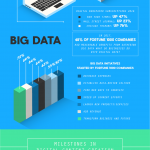How Being Married To A Novelist Has Made Me A Better Entrepreneur
I’m the founder of a video marketing platform, but my wife grew up without a TV.
As a kid, Donna spent her days scanning Reader’s Digest with her grandmother, reading “Laughter is the Best Medicine” together and testing each other’s “Word Power.” All through childhood, she wrote her own stories; today she’s a fiction writer–basically the polar opposite of my job as the analytics-driven chief at the startup I cofounded.
But I’ve still learned a lot about creativity and the creative process from Donna, and that’s translated into some unexpectedly hard-nosed insights about growing a startup. By necessity, creative people are ruthless, incisive entrepreneurs. Competition is intense, the market is tight, and getting noticed is always an uphill slog.
All romantic notions aside, being a writer–or a creative of any kind–is incredibly hard work, and I’ve learned firsthand that practitioners have plenty to teach the startup world.
Startups Aren’t The Only Things That Fail (So Get Over Yourself)
By most estimates, somewhere between 75% and 90% of startups fail, but if you think that’s hard, try being a book author. It typically takes six months to even hear back from an editor about your manuscript, and after that, by one reckoning, only three out of every 10,000 actually get published–not great odds.
So instead of struggling to get her book proposal noticed at a mainstream publishing house, my wife adjusted her game plan and began to crowdfund her novel independently. She was able to raise money quickly and ultimately publish her book–but only because she allowed herself to change course from her original vision.
In the startup world, too many founders fall in love with their original ideas, sit and wait for customers to come to them, then get disillusioned when they don’t gain traction. But pliability early on can be far more valuable than blind persistence. My company, Vidyard, started as a video production company. But when customers starting clamoring for tools to monitor video analytics, we took a risk and made the switch. It completely changed our vision and business model, but we weren’t too precious about either–and that probably saved us from a face-plant.
Creativity Is Nothing To Romanticize
It’s no secret that creativity is fundamental to any successful workplace. The problem is that business people tend to romanticize the creative process. But ultimately, it’s work–just a different type than what we’re generally used to.
The reality is that creativity can rarely flourish without constraints. As gifted a writer as Donna is, she meticulously structures her narratives before the creative process kicks in. She almost has an algorithm for the emotional beats of a story, and sets an outline and deadline for each chapter before getting creative with the details. These rules help her channel imagination into tangible results.
I’ve learned that the same can apply in the workplace. Taking a cue from Donna’s process, we now do something at my company called “Pitchyard”: It’s essentially product brainstorming, with tight rules and a timeline. Over two weeks, cross-functional 10-person teams draw up briefs for upgrades or totally new products. The results of this kind of “constrained creativity” have been eye opening. Recent sessions, for example, inspired ViewedIt, a new tool—already downloaded hundreds of thousands of times—that lets anyone make a video, with live screenshots, and share it via email.
Isolation Can Be A Killer
Donna struggled to find the time to write the latest chapters of her novel Where the Sun Sets while also juggling crowdfunding. The pressure of doing it all by herself was overwhelming. But instead of turning inward, she looked for help–and when there wasn’t any, she started a video series interviewing other writers on their blockers and solutions. Sometimes when you’re hitting a wall, the best thing to do is to carve out time to find support, not try and double down on your own.
That’s proved a useful lesson for me, too. Founders are bootstrappers by nature. We think we can fix anything ourselves. But more often than not, the answer is already out there, if we’re just willing to ask around and listen. When I was struggling recently with structuring a new round of financing, I opened up to a colleague to help generate some more ideas. Later, when we were rejigging our pricing model, we went out and spoke to other startups that were built on tiered pricing.
It’s a simple fix–just talking–but a powerful way to break the culture of isolation that entrepreneurship seems to encourage and even valorize.
Know Your End User
A hard lesson that Donna learned quickly was that you write for an audience, not just for yourself. She’d dreamed of writing the next great young-adult wizard-based adventure, but the market was totally saturated. She realized she had to shift her sights, and now works on stories aimed at an underserved market of Baby Boomer readers.
For businesses, it’s equally important to know your audience. You don’t create a successful product in isolation, no matter how innovative it may be. As Salesforce’s Peter Coffee and many others have insisted, innovation requires both invention and people adopting that invention. The Bay Area (not to mention our own backyard in Waterloo, Ontario) is filled with founders building new technology. But if you’re not connecting with a user base, then you’re not producing much change–nor are you making any money.
I don’t want to conflate the world of fiction writing and the world of entrepreneurship, which are very different. At the root, however, doing either right depends on something obvious and downright clichéd but too often overlooked: passion. Your work has to come from a true belief in the product and an excitement for what you’re doing–whether that’s a novel or a video analytics platform. I’m grateful to my wife for never letting me lose sight of that lesson, either.
Michael Litt is cofounder and CEO of the video marketing platform Vidyard. Follow him on Twitter at @michaellitt
Fast Company , Read Full Story
(29)














